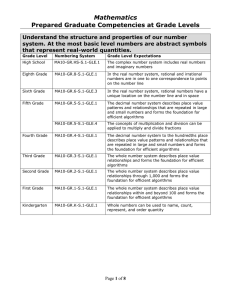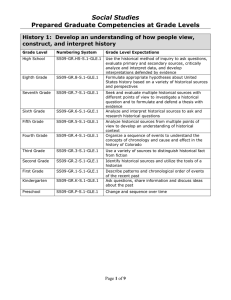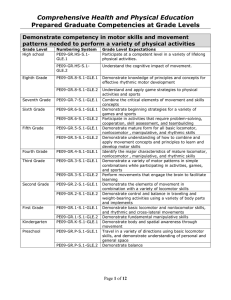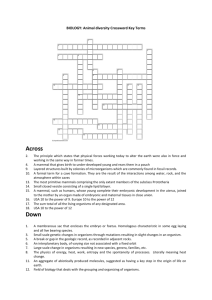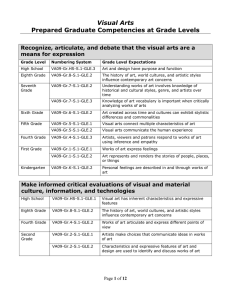Observe, explain, and predict natural phenomena governed by
advertisement
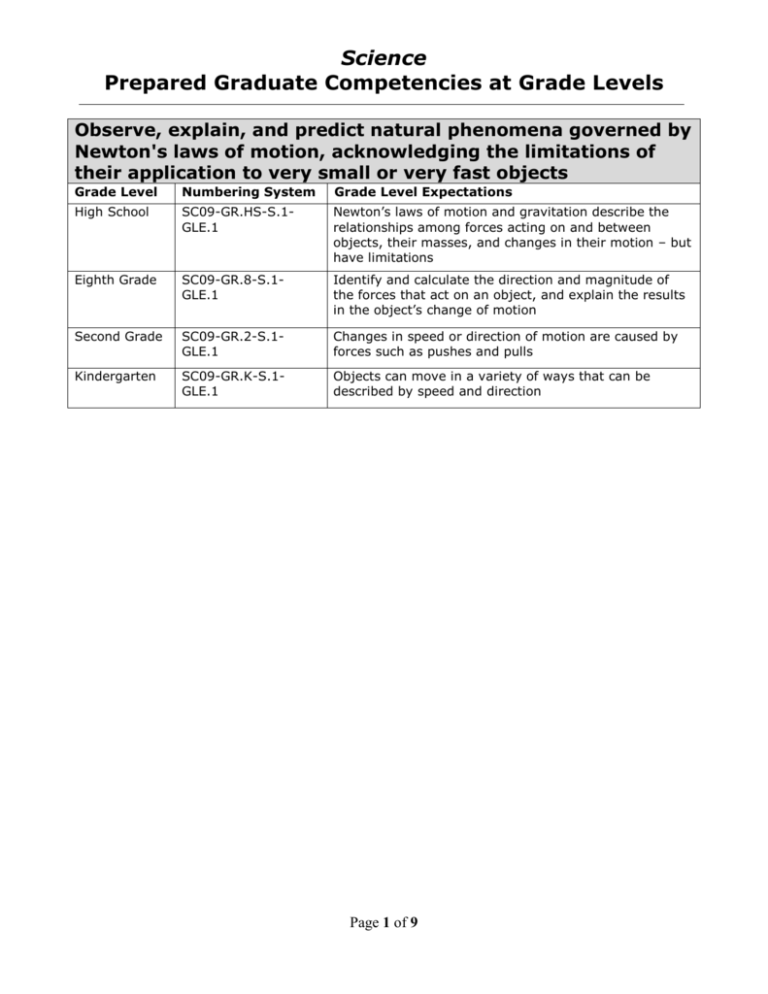
Science Prepared Graduate Competencies at Grade Levels Observe, explain, and predict natural phenomena governed by Newton's laws of motion, acknowledging the limitations of their application to very small or very fast objects Grade Level Numbering System Grade Level Expectations High School SC09-GR.HS-S.1GLE.1 Newton’s laws of motion and gravitation describe the relationships among forces acting on and between objects, their masses, and changes in their motion – but have limitations Eighth Grade SC09-GR.8-S.1GLE.1 Identify and calculate the direction and magnitude of the forces that act on an object, and explain the results in the object’s change of motion Second Grade SC09-GR.2-S.1GLE.1 Changes in speed or direction of motion are caused by forces such as pushes and pulls Kindergarten SC09-GR.K-S.1GLE.1 Objects can move in a variety of ways that can be described by speed and direction Page 1 of 9 Science Prepared Graduate Competencies at Grade Levels Apply an understanding of atomic and molecular structure to explain the properties of matter, and predict outcomes of chemical and nuclear reactions Grade Level Numbering System Grade Level Expectations High School SC09-GR.HS-S.1GLE.2 Matter has definite structure that determines characteristic physical and chemical properties SC09-GR.HS-S.1GLE.3 Matter can change form through chemical or nuclear reactions abiding by the laws of conservation of mass and energy SC09-GR.HS-S.1GLE.4 Atoms bond in different ways to form molecules and compounds that have definite properties Eighth Grade SC09-GR.8-S.1GLE.3 Distinguish between physical and chemical changes, noting that mass is conserved during any change Seventh Grade SC09-GR.7-S.1GLE.1 Mixtures of substances can be separated based on their properties such as solubility, boiling points, magnetic properties, and densities Sixth Grade SC09-GR.6-S.1GLE.1 All matter is made from atoms, which are far too small to see directly through a light microscope. Elements have unique atoms and thus, unique properties. Atoms themselves are made from even smaller particles Atoms may stick together in well-defined molecules or be packed together in large arrangements. Different arrangements of atoms into groups compose all substances The physical characteristics and changes of solid, liquid, and gas states can be explained using the particulate model SC09-GR.6-S.1GLE.2 SC09-GR.6-S.1GLE.3 SC09-GR.6-S.1GLE.4 Distinguish among, explain, and apply the relationships among mass, weight, volume, and density Fifth Grade SC09-GR.5-S.1GLE.1 Mixtures of matter can be separated regardless of how they were created; all weight and mass of the mixture are the same as the sum of weight and mass of its parts Third Grade SC09-GR.3-S.1GLE.1 SC09-GR.1-S.1GLE.1 SC09-GR.K-S.1GLE.2 SC09-GR.P-S.1GLE.1 SC09-GR.P-S.1GLE.2 Matter exists in different states and can change from one state to another by heating and cooling Solids and liquids have unique properties that distinguish them Objects can be sorted by physical properties, which can be observed and measured Objects have properties and characteristics First Grade Kindergarten Preschool There are cause-and-effect relationships in everyday experiences Page 2 of 9 Science Prepared Graduate Competencies at Grade Levels Apply an understanding that energy exists in various forms, and its transformation and conservation occur in processes that are predictable and measurable Grade Level Numbering System Grade Level Expectations High School SC09-GR.HS-S.1GLE.5 Energy exists in many forms such as mechanical, chemical, electrical, radiant, thermal, and nuclear, that can be quantified and experimentally determined SC09-GR.HS-S.1GLE.6 When energy changes form, it is neither created not destroyed; however, because some is necessarily lost as heat, the amount of energy available to do work decreases SC09-GR.8-S.1GLE.2 There are different forms of energy, and those forms of energy can be changed from one form to another – but total energy is conserved SC09-GR.HS-S.1GLE.4 Recognize that waves such as electromagnetic, sound, seismic, and water have common characteristics and unique properties SC09-GR.4-S.1GLE.1 Energy comes in many forms such as light, heat, sound, magnetic, chemical, and electrical Eighth Grade Fourth Grade Page 3 of 9 Science Prepared Graduate Competencies at Grade Levels Analyze the relationship between structure and function in living systems at a variety of organizational levels, and recognize livings systems’ dependence on natural selection Grade Level Numbering System Grade Level Expectations High School SC09-GR.HS-S.2GLE.3 Cellular metabolic activities are carried out by biomolecules produced by organisms SC09-GR.HS-S.2GLE.4 The energy for life primarily derives from the interrelated processes of photosynthesis and cellular respiration. Photosynthesis transforms the sun’s light energy into the chemical energy of molecular bonds. Cellular respiration allows cells to utilize chemical energy when these bonds are broken Cells use the passive and active transport of substances across membranes to maintain relatively stable intracellular environments SC09-GR.HS-S.2GLE.5 SC09-GR.HS-S.2GLE.6 Cells, tissues, organs, and organ systems maintain relatively stable internal environments, even in the face of changing external environments SC09-GR.7-S.2GLE.2 The human body is composed of atoms, molecules, cells, tissues, organs, and organ systems that have specific functions and interactions SC09-GR.7-S.2GLE.3 Cells are the smallest unit of life that can function independently and perform all the necessary functions of life SC09-GR.7-S.2GLE.4 Photosynthesis and cellular respiration are important processes by which energy is acquired and utilized by organisms SC09-GR.5-S.2GLE.2 SC09-GR.2-S.2GLE.2 SC09-GR.1-S.2GLE.2 Human body systems have basic structures, functions, and needs Each plant or animal has different structures or behaviors that serve different functions An organism is a living thing that has physical characteristics to help it survive Kindergarten SC09-GR.K-S.2GLE.1 Organisms can be described and sorted by their physical characteristics Preschool SC09-GR.P-S.2GLE.1 Living things have characteristics and basic needs SC09-GR.P-S.2GLE.2 Living things develop in predictable patterns Seventh Grade Fifth Grade Second Grade First Grade Page 4 of 9 Science Prepared Graduate Competencies at Grade Levels Explain and illustrate with examples how living systems interact with the biotic and abiotic environment Grade Level High School Numbering System SC09-GR.HS-S.2GLE.1 Grade Level Expectations Matter tends to be cycled within an ecosystem, while energy is transformed and eventually exits an ecosystem SC09-GR.HS-S.2GLE.2 The size and persistence of populations depend on their interactions with each other and on the abiotic factors in an ecosystem Eighth Grade SC09-GR.8-S.2GLE.1 Human activities can deliberately or inadvertently alter ecosystems and their resiliency Sixth Grade SC09-GR.6-S.2GLE.1 Changes in environmental conditions can affect the survival of individual organisms, populations, and entire species SC09-GR.6-S.2GLE.2 Organisms interact with each other and their environment in various ways that create a flow of energy and cycling of matter in an ecosystem Fourth Grade SC09-GR.4-S.2GLE.3 There is interaction and interdependence between and among living and nonliving components of ecosystems Second Grade SC09-GR.2-S.2GLE.1 Organisms depend on their habitat’s nonliving parts to satisfy their needs Preschool SC09-GR.P-S.2GLE.1 Living things have characteristics and basic needs SC09-GR.P-S.2GLE.2 Living things develop in predictable patterns Page 5 of 9 Science Prepared Graduate Competencies at Grade Levels Analyze how various organisms grow, develop, and differentiate during their lifetimes based on an interplay between genetics and their environment Grade Level Numbering System Grade Level Expectations High school SC09-GR.HS-S.2GLE.7 Physical and behavioral characteristics of an organism are influenced to varying degrees by heritable genes, many of which encode instructions for the production of proteins Multicellularity makes possible a division of labor at the cellular level through the expression of select genes, but not the entire genome. SC09-GR.HS-S.2GLE.8 Eighth Grade SC09-GR.8-S.2GLE.2 Organisms reproduce and transmit genetic information (genes) to offspring, which influences individuals’ traits in the next generation Fifth Grade SC09-GR.5-S.2GLE.1 All organisms have structures and systems with separate functions Fourth Grade SC09-GR.4-S.2GLE.1 All living things share similar characteristics, but they also have differences that can be described and classified Third Grade SC09-GR.3-S.2GLE.1 The duration and timing of life cycle events such as reproduction and longevity vary across organisms and species First Grade SC09-GR.1-S.2GLE.1 Offspring have characteristics that are similar to but not exactly like their parents’ characteristics Preschool SC09-GR.P-S.2GLE.2 Living things develop in predictable patterns Page 6 of 9 Science Prepared Graduate Competencies at Grade Levels Explain how biological evolution accounts for the unity and diversity of living organisms Grade Level High School Numbering System SC09-GR.HS-S.2GLE.9 Seventh Grade SC09-GR.7-S.2-GLE.1 Fourth Grade Grade Level Expectations Evolution occurs as the heritable characteristics of populations change across generations and can lead populations to become better adapted to their environment Individual organisms with certain traits are more likely than others to survive and have offspring in specific environments SC09-GR.7-S.2-GLE.5 Multiple lines of evidence show the evolution of organisms over geologic time SC09-GR.4-S.2-GLE.2 Comparing fossils to each other or to living organisms reveals features of prehistoric environments and provides information about organisms today Describe and interpret how Earth's geologic history and place in space are relevant to our understanding of the processes that have shaped our planet Grade Level Numbering System Grade Level Expectations High School SC09-GR.HS-S.3GLE.1 The history of the universe, solar system and Earth can be inferred from evidence left from past events SC09-GR.HS-S.3GLE.2 As part of the solar system, Earth interacts with various extraterrestrial forces and energies such as gravity, solar phenomena, electromagnetic radiation, and impact events that influence the planet’s geosphere, atmosphere, and biosphere in a variety of ways The solar system is comprised of various objects that orbit the Sun and are classified based on their characteristics Eighth Grade SC09-GR.HS-S.3GLE.3 Seventh Grade SC09-GR.HS-S.3GLE.2 Geologic time, history, and changing life forms are indicated by fossils and successive sedimentation, folding, faulting, and uplifting of layers of sedimentary rock Fourth Grade SC09-GR.4-S.3GLE.1 Earth is part of the solar system, which includes the sun, moon, and other bodies that orbit the sun in predictable patterns that lead to observable paths of objects in the sky as seen from Earth Preschool SC09-GR.P-S.3GLE.2 Events such as night, day, the movement of objects in the sky, weather, and seasons have patterns Page 7 of 9 Science Prepared Graduate Competencies at Grade Levels Evaluate evidence that Earth’s geosphere, atmosphere, hydrosphere, and biosphere interact as a complex system Grade Level High School Numbering System SC09-GR.HS-S.3GLE.3 Grade Level Expectations The theory of plate tectonics helps to explain geological, physical, and geographical features of Earth SC09-GR.HS-S.3GLE.4 Climate is the result of energy transfer among interactions of the atmosphere, hydrosphere, geosphere, and biosphere SC09-GR.HS-S.3GLE.6 The interaction of Earth's surface with water, air, gravity, and biological activity causes physical and chemical changes SC09-GR.HS-S.3GLE.7 Natural hazards have local, national and global impacts such as volcanoes, earthquakes, tsunamis, hurricanes, and thunderstorms SC09-GR.8-S.3GLE.1 Weather is a result of complex interactions of Earth's atmosphere, land and water, that are driven by energy from the sun, and can be predicted and described through complex models SC09-GR.8-S.3GLE.2 Earth has a variety of climates defined by average temperature, precipitation, humidity, air pressure, and wind that have changed over time in a particular location Sixth Grade SC09-GR.6-S.3GLE.1 Complex interrelationships exist between Earth’s structure and natural processes that over time are both constructive and destructive Fifth Grade SC09-GR.5-S.3GLE.2 Earth’s surface changes constantly through a variety of processes and forces SC09-GR.5-S.3GLE.3 Weather conditions change because of the uneven heating of Earth’s surface by the Sun’s energy. Weather changes are measured by differences in temperature, air pressure, wind and water in the atmosphere and type of precipitation Earth’s materials can be broken down and/or combined into different materials such as rocks, minerals, rock cycle, formation of soil, and sand – of which are usable resources for human activity Eighth Grade Third Grade SC09-GR.3-S.3GLE.1 Second Grade SC09-GR.2-S.3GLE.1 Weather and the changing seasons impact the environment and organisms such as humans, plants, and other animals Page 8 of 9 Science Prepared Graduate Competencies at Grade Levels Describe how humans are dependent on the diversity of resources provided by Earth and sun Grade Level Numbering System Grade Level Expectations High school SC09-GR.HS-S.3GLE.5 There are costs, benefits, and consequences of exploration, development, and consumption of renewable and nonrenewable resources Sixth Grade SC09-GR.6-S.3GLE.2 Water on Earth is distributed and circulated through oceans glaciers, rivers, ground water, and the atmosphere SC09-GR.6-S.3GLE.3 Earth’s natural resources provide the foundation for human society’s physical needs. Many natural resources are non-renewable on human time scales, while others can be renewed or recycled. Fifth Grade SC09-GR.5-S.3GLE.1 Earth and Sun provide a diversity of renewable and nonrenewable resources First Grade SC09-GR.1-S.3GLE.1 Earth’s materials can be compared and classified based on their properties Preschool SC09-GR.P-S.3GLE.1 Earth’s materials have properties and characteristics that affect how we use those materials Page 9 of 9
